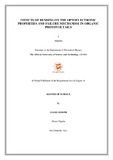| dc.contributor.author | Asare, Joseph | |
| dc.date.accessioned | 2017-01-09T15:31:15Z | |
| dc.date.available | 2017-01-09T15:31:15Z | |
| dc.date.issued | 2011-12-15 | |
| dc.identifier.uri | http://repository.aust.edu.ng:8080/xmlui/handle/123456789/534 | |
| dc.description.abstract | This research investigates the effects of bending on the electrical, optical, structural and mechanical properties of flexible organic photovoltaic (OPV) cells. Bulk heterojunction organic solar cells were fabricated on Polyethylene terephthalate (PET) substrates using Poly-3-hexylthiophene: [6, 6]-phenyl-C61-butyric acid methyl ester (P3HT: PCBM) as the active layer and Poly (3, 4-ethylenedioxythiophene) Polystyrenesulfonate (PEDOT: PSS) as the hole injection layer. All the organic layers were deposited by spin coating while the Al cathode was vacuum thermally evaporated. The Indium Tin Oxide (ITO)
anode has an average optical transmittance of 85% in the visible spectrum, a sheet resistivity of 60 ohms per square and an average surface roughness of 3nm. The relationship between the optoelectronic performance of the various device layers and the applied mechanical strains has been analyzed. The effects of stress and strain on the current-voltage characteristics of the device and its failure were modeled using the Abaqus software. | en_US |
| dc.description.sponsorship | AUST | en_US |
| dc.language.iso | en | en_US |
| dc.subject | Asare Joseph | en_US |
| dc.subject | Prof Wole Soboyejo | en_US |
| dc.subject | Organic Photovoltaics | en_US |
| dc.subject | Optoelectronic Properties | en_US |
| dc.title | Effects of Bending on the Optoelectronic Properties and Failure Mechanism in Organic Photovoltaics | en_US |
| dc.type | Thesis | en_US |

